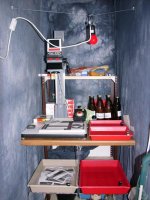wgerrard
Veteran
Not too long ago I posted a question about the ins and outs of developing my own b&w with the intention of scanning it. I got lots of fine answers and now await the UPS truck bringing a box of goodies, including 6 rolls of Tri-X and some Xtol. (The Kodak blurb about Xtol's characteristics appealed to me. Most folks pitched Diafine to me, but I like the Xtol images I've seen better. Dissenting opinions welcome.)
Then... I just suffered through another batch of scanning some slides. On my Nikon Coolscan IV ED. Grind grind, whirl, whirl. You all know how it goes.
So, I think, maybe I ought to target doing prints in a real honest-to-God darkroom. Maybe I can do b&w and process and print myself, send my slides and C41 of to a place like NCPS for processing and scanning, and sell the Coolscan. At least I wouldn't have to wonder what those scanned b&w shots would really look like if someone printed them.
Maybe.
I live in a 2-bedroom flat, with two small bathrooms. No other rooms are practical for this use. I could seal either one to block light. The issue is space, and there isn't much. The largest is about 6x10, before the cabinetry, tub and shower, etc. go in. Counter space is really limited. No ventilation other than an exhaust fan.
What's the smallest practical space in which I can set up, and repeatedly tear down, a wet darkroom? Can I fit it in that dinky bathroom.
Then... I just suffered through another batch of scanning some slides. On my Nikon Coolscan IV ED. Grind grind, whirl, whirl. You all know how it goes.
So, I think, maybe I ought to target doing prints in a real honest-to-God darkroom. Maybe I can do b&w and process and print myself, send my slides and C41 of to a place like NCPS for processing and scanning, and sell the Coolscan. At least I wouldn't have to wonder what those scanned b&w shots would really look like if someone printed them.
Maybe.
I live in a 2-bedroom flat, with two small bathrooms. No other rooms are practical for this use. I could seal either one to block light. The issue is space, and there isn't much. The largest is about 6x10, before the cabinetry, tub and shower, etc. go in. Counter space is really limited. No ventilation other than an exhaust fan.
What's the smallest practical space in which I can set up, and repeatedly tear down, a wet darkroom? Can I fit it in that dinky bathroom.


